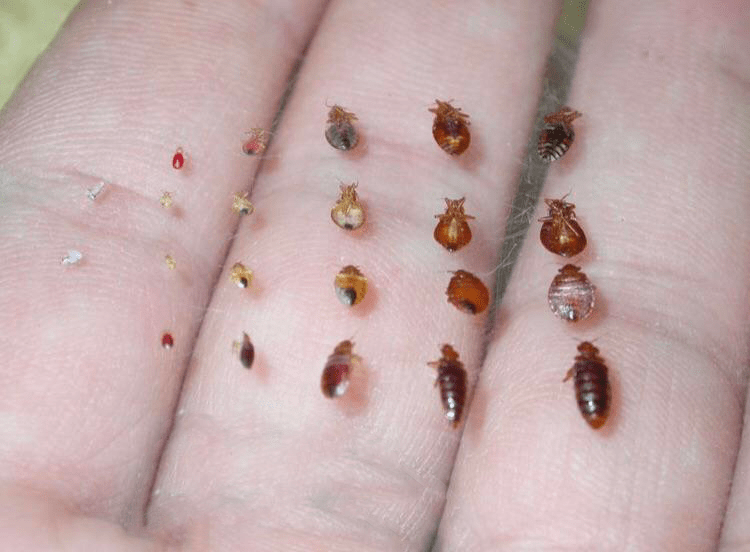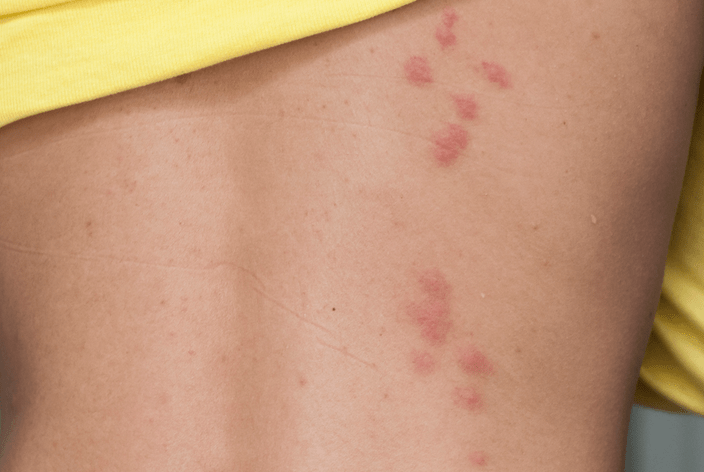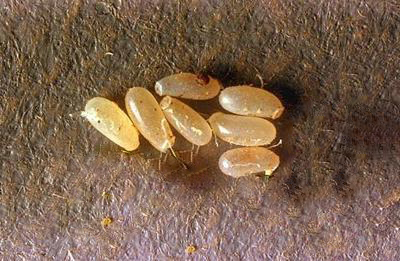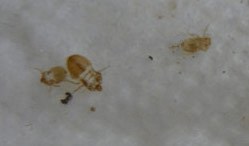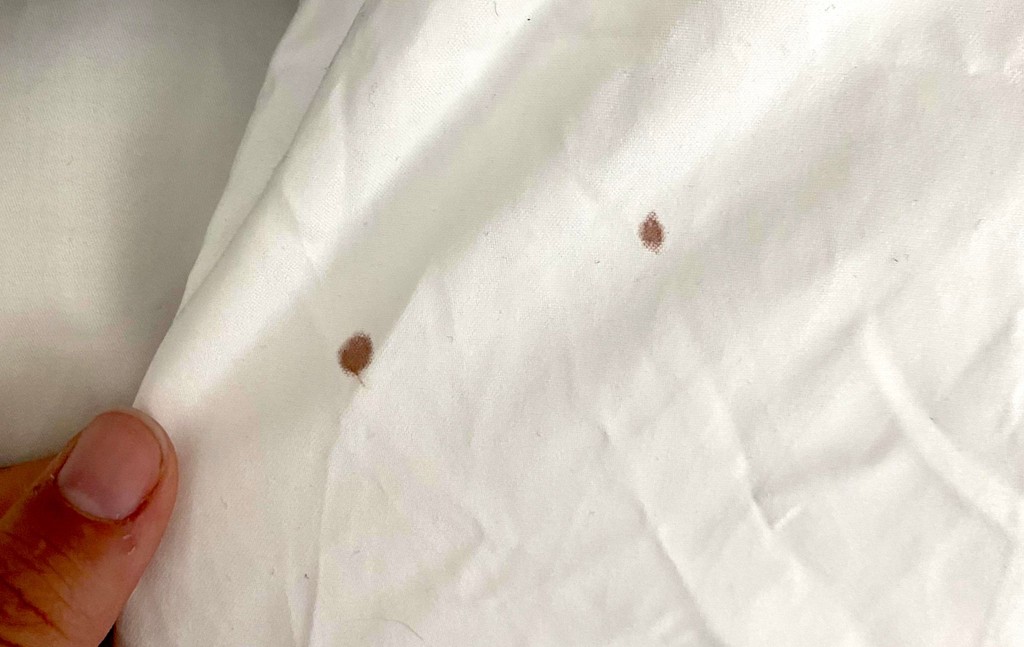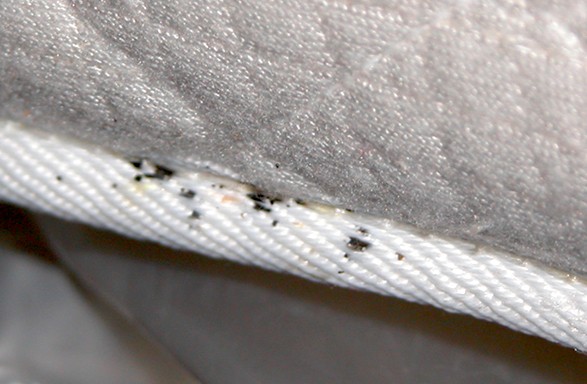Do you have a bed bug infestation and want to find out how to check for bed bugs? Read this article till the end.
Checking for bed bugs is a difficult job, no doubt. In this blog post, you will find everything you need to check for bed bugs. We have covered some important questions that will aid you in the process. We have also shared some tips and tricks that will help keep bed bugs as far away from your home as possible.
Table of Contents
Know Your Enemy
What Are Bed Bugs?
Bed bugs are small, wingless insects from the genus Cimex. They live on the blood of warm-blooded animals. Especially human blood. There are about 90 species of bed bugs. Only three of them feed on humans. Cimex hemipterus, Leptocimex boueti, and Cimex lectularius are the types of Bedbugs that feed on human blood.
What Do Bed Bugs Look Like?
Bed Bugs are tiny balloon-like creatures with a reddish-brown colour. They have an oval and flattened shape. They are very small – about the size of a mustard grain. They are visible with naked eyes. Adult bed bugs can grow up to 0.25-0.30 inches. Bed bugs, usually, bite during the night. A bed bug bite can cause itching, allergies, blisters and red spots, insomnia, etc.
Can You See Bed Bugs With Naked Eyes?
Yes, you can see bed bugs with naked eyes. Although they are very small in size, they are still visible. Detecting them is difficult due to their small sizes. What’s even more challenging is that they can hide in tiny cracks and crevices. Nymphs (newborns) and eggs are more difficult to detect with naked eyes. Nymphs are about three times smaller than a full-grown bed bug. Besides, they are lighter in colour. You might consider using a UV flashlight and magnifying glass.
Favourite Hours For Bed Bugs
Bed bugs are considered nocturnal. They are most active during the night. They prefer darkness and bite mostly at night. Their favourite hours for a blood meal would be between 1 AM to 3 AM. However, that doesn’t mean bed bugs do not bite in the daytime. They are as likely to bite during the day as night. When hungry, bed bugs can come out of their hiding – and feed on their host during the day as well.
How Do You Get Bed Bugs?
Bed bugs do not enter your house on their own. They are a result of human travelling and shopping. You can even get Bed Bugs by visiting your friends. Travel is the most common cause of bed bug infestation. Bed bugs are hitchhikers. They can crawl onto your belongings. Guests can bring bed bugs with them, too. Bed Bugs also enter your house from other infested areas or used furniture. They even travel from one room to another in complexes, malls, and hotels.
How Fast Do Bed Bugs Spread?
If both male and female bugs intake their blood meal once within 14 days, the female can lay 1 to 5 eggs a day. If she has had her meal again after 14 days, she can start another egg-laying cycle until the next feed. Thus, within 6 months of mating, an individual female bed bug can produce thousands of bugs.
Note also that bed bugs can crawl at a speed of 3 to 4 feet per minute. Their speed allow them to travel between rooms, floors and apartment in the the same building.
How Long Does It Take To See The First Signs Of An Infestation?
Generally, a bed bug takes up to 7-8 weeks to grow into a full-sized adult. So, if there’s an infestation, it’s been there for at least seven weeks or more.
If you have a bed bug interception device installed in your home, you can detect an infestation. 80 per cent of low-level bed bug infestations can be analyzed in 1 or 2 weeks by interception cups. If you don’t have a bed bug trapping device installed, it would take 6-8 weeks for you to see the first signs of the infestation.
Where Do Bed Bugs Bite?
Bed bugs, usually, bite on the exposed parts of the skin, such as the upper body, neck, arms, and shoulders. People tend to develop itching, red welts, or swelling the day after being bitten. However, bites may not register for several days or at all on some individuals. In some cases, the bites may develop into fluid-filled blisters.
Do Bed Bugs Live On People?
Bed bugs don’t live on your body. But they choose to live near your body. Bed Bugs prefer areas closer to where people stay. The bed, mattress, couch are some of its go-to spots. This allows them to feed on their host’s blood with ease. Once they complete their meal, they return to their safe location to digest the blood. It takes them a few weeks to digest it completely.
Bed bugs feed on your pets as well. They need a blood host to stay alive. They don’t care if it’s adult humans, kids, or animalst. Your pets are likely to develop similar symptoms that a human develops. Redness, itching, blisters, black spots etc. Keep a check on your pet’s behaviour. Also, make sure you check their beds. This may help you indicate if there’s a bed bug infestation at your home.
Common Infestation Signs of bed bugs
Do you see bites on your body when you wake up in the morning? If yes, there’s a good chance your home is infested with bed bugs. The bites can also be mistaken for those of other insects. But how can you detect their presence? In the initial phases, people only see the infestation signs. Pay attention to the signs to make sure it’s a bed bug infestation before spending on bed bug control.
Here are some common infestation signs that will help you detect bed bugs.
- A Musty Smell: If there’s a sweet, musty odour in your sleeping area, there may be a heavy bed bug infestation. Bed bugs produce a certain chemical to attract others.
- Eggs: After mating, the females leave behind eggs or newborns. These are small and may not be visible to the naked eye. You may want to use a UV flashlight to see the bedbugs’s eggs.
- Exoskeletons: Another way to detect bed bugs is to inspect the exoskeletons. See if they have left behind their outer shell.
- Bite: Bed bugs can bite anywhere on the exposed skin. Generally, bed bugs bite on the neck, face, arms, legs, hands, etc. They feed when the person is sleeping. Bites on the skin are a poor indicator of bed bug infestation because it can be mistaken with bites from mites, fleas or mosquitoes.
- Blood Stains: Bed bugs feed on you for up to one hour while you sleep. If you move while sleeping you may crush them on your sheets. You should then notice blood stains in your sheets. The best is to use white sheets if you want to see the blood stains.
- Black Specks: If you come across tiny, black specks, it could be bed bug excrement.
Tools that can help you finding bed bugs
When searching for bed bugs, you need a sufficient amount of light. This makes it easier for you to detect bugs. During the day, you have the advantage of natural light. Open all the windows in your room, pull down the curtain, and let the sunlight come in.
The best tool to help you find a bed bug infestation on your own is a UV flashlight and magnifying glass. Bed bugs hide in the gaps and corners – in the dark. Thus, you would need a flashlight to see through the dark. Moreover, bed bugs are small in size. A magnifying glass will give you a locked-in view. This will help you in the inspection process.
A good way to check for bed bugs is to use a bed bug trap. Bed bug interceptors placed under the legs of your bed can help you check for infestation throughout the year. The traps will help you detect an infestation quickly. Speed matter when it comes to stop bed bugs.
Now, with the help of these tools, check around their hiding spots. Beds, couches, pillows, mattresses, electrical appliances, window sills, door frames, and other areas. Look for eggs, moulted skin, faeces – as evidence of infestation. Make sure you look at the gaps, cracks, crevices, folds of fabric, and furniture. Don’t miss out on the electricity boards, too. They might infest those areas as well.
How To Draw Bed Bugs Out Of Hiding?
Bed bug infestation can be frustrating. While it’s best to opt for treatment, there are a few things you can do to draw them out of hiding. Once you have detected the presence of bed bugs, use these 4 methods to flush them out.
1. Drawing bed bugs out by Hands
The good old technique. Once you have detected their hiding place, use a flattened object. You can use a credit card, putty knife, or play card to force them out. Hold the edge of the object against the surface. Angle it to cover more ground. This isn’t the best method to draw every single bug out. But it’s helpful to reduce their numbers. Then you can use a damp cloth or a piece of tape to trap them. Stickier tapes, such as duct tape, offer better results. Don’t dispose of them in the garbage. It would spread in the nearby areas. If you want to get rid of them, you have to kill them.
Tip: Use protective gloves to prevent any kind of infection. Wash your hands once you’re done.
2. Drawing bed bugs out with Hair Dryer (heating)
Evicting bed bugs with heat is most effective. The hair dryer method forces bed bugs out of all the hard-to-reach spots. Cracks, pipes, electrical faceplates, narrow openings, etc. Bugs are sensitive to high temperatures. To draw them out, set your hairdryer to high-heat mode and blow it in their direction. Hold the nozzle of the hairdryer 3-4 inches away. Make sure to direct the heat over places where you think they may be hiding. The heat will cause the bugs to come out within a few seconds. However, if you don’t detect any signs of activity, opt for the next step.
Tip: Continuous heat for up to 30 seconds from a hair dryer can kill bed bugs.
3. Drawing bed bugs out by Pesticides
Pyrethrin or pyrethroid-based home pesticide can be effective against bed bugs. You can find these active ingredients in any local store or online. Apply the pesticide to the target area for a few seconds – long enough to dampen the surface. Focus on all the places that bed bugs might harbour. Once you’re done, you will see the bugs exiting in a few minutes. You can also use a fogger. It is a type of pesticide application device. This spreads the chemical throughout the room.
Warning: The pesticide that you purchase should be for home use. Outdoor or agricultural pesticides can make everyone in your family sick.
Tip: Wear a mask while applying the pesticide. Overexposure can cause health symptoms. Nausea, headache, dizziness, diarrhoea, etc are common. Also, don’t apply pesticides on/near your bed. The chemicals can break down and cause uncomfortable symptoms.
4. Use carbon dioxide to bait bed bugs
Carbon dioxide is one of the best DIY bed bug traps. This trap consists of a mixture of sugar, yeast, and water. The mixture is then dropped in an upside-down dog bowl (so that bed bugs can’t get out of it). This releases carbon dioxide, which attracts bed bugs to climb in and fall inside the bowl. The bowl must be deep enough so that no bed bugs can climb out. Bed bugs use a carbon dioxide smell to find their host – so, it becomes easy to trap them. This technique, however, won’t work if they have had their meal recently.
How To Check For Bed Bugs At Home?
Bed bugs are small insects. They can manage to fit into the smallest cracks. They like to stay near their blood host. They are more often found in the bedroom, workspace, couches, and so on. So, how to check for bed bugs?
Step 1: Inspect common hiding spots
Once you are aware there’s a bed bug infestation at your home, inspect the common hiding spots. These include the beds, couches, pillows, mattresses, electrical appliances, window sills, door frames, etc. Use your flashlight and a flat-edged object. A putty knife, credit card etc. to examine your nightstand and drawers. Turn your drawers over and check the bottoms as well. Inspect the ceiling, curtains, drapes, under lamps, picture frames. Look inside the alarm clocks, home electronics, behind outlet covers, and loose wallpapers.
Bed bugs are treated directly. Thus, you should look for every nook and corner in your home. Don’t miss out on a single spot. This gives you an exact target on where to treat bed bugs. And avoid chemical wastage.
Step 2: Place some traps and hold
There are several bed bug devices/traps available in the market which you can use to catch the bugs. One such device is the interceptor cup. It contains a large plastic dish. This helps trap and retain the bugs. These are also called pitfalls traps for bed bugs. To use them, you need to place them under your bedpost. Make sure your bed isn’t touching the wall. Thus, if there’s an infestation, the device will catch the bugs and you will be notified in a few days.
Step 3: Inspect blood stains
If you have looked around and still can’t find bed bugs – search for bloodstains. Bed bugs are smart. They might as well escape your eyesight. Inspect blood stains on your sheets and pillow covers. Check other fabrics and clothes. Examine the seams, folds, and tufts of your mattress, too. Don’t forget the carpets and doormats.
Watch the following video at 2 minutes and 50 seconds to for a demonstration on how to check.
How To Check For Bed Bugs At Hotels/Motels/Shops?
While checking into hotels, it’s important to look out for bed bugs. Hotels, motels, and even thrift stores can be their favourite breeding places. Often, unbeknownst people bring home bed bugs. They can hitch a ride on your luggage or clothing. Therefore, inspect the place well before entering.
Here’s what you can do to check (and avoid) bed bugs at hotel/motel rooms:
- When you first enter a new hotel room, keep your luggage in a place where bed bugs don’t hide. Maybe the bathroom or the luggage rack. Then inspect the bedding and the side furniture. Check the couches and the recliners, too.
- Pull back the sheets and blankets. Inspect the seams and the mattress. These are the best places for bed bug infestations. Adults, newborns, even eggs are visible to naked eyes. For a better glance, switch on your flashlight. You can also lift the mattress and check underneath.
- Keep your luggage stowed. Zip it close or maybe store it in a large plastic trash bag. This cuts contact with the bed bugs. Also, don’t spread your stuff around. If there are bed bugs, they will hitch onto your things. The less you spread your belongings, the more you can avoid contact.
- Finally, when you get home, wash your stuff in a hot dryer for half an hour. Heat kills bed bugs; washing the clothes at low temperature won’t. You can also use a steamer for maximum efficiency.
How Professionals Detect Bed Bugs
Professionals use steam to get rid of bed bugs. Bed bugs and their eggs die at 122°F (50°C). Temperatures above 212°F (100°C) will immediately kill the bugs. Exterminators also use chemical fertilisers (pyrethrins and pyrethroids) to treat an infestation.
Professional use also dogs to detect bed bugs. Pest control providers train dogs to smell the chemical that bed bugs release. They can occasionally mistake signs of old infestations but it can be confirmed with a visual inspection.
Bed bugs sniffing dogs are expensive for pest control companies (up to $50,000). This expense is passed to customers when you call them and it’s why most providers charge a consultation fee. Depending of the place and the size of your home, canine inspections can cost between $50 to $600.
I Found Bed Bugs, Then What To Do?
Once you find bed bugs, you need to catch them and kill them as early as possible. Many methods exists and it’s often better to use a combination of them. Below we listed some of them.
- Use natural methods like Diatomaceous Earth (DE)
- Install active monitors or interceptors under your bed.
- Install Mattress/Box Spring Encasements
- Use a steamer to kill bed bugs
Minor infestations are easy to treat. With patience you can also get rid of a major infestation. For more information read our guide How To Get Rid Of Bed Bugs?
After you solve your problem, continue to monitor your home on a weekly basis for new infestation. You should monitor even if a professional did the job because a few bed bugs left can blown up into a full new infestation.
Frequently Asked Questions
Do Bed Bugs Live On Metal Frame Beds?
Bed bugs are more likely to live near wooden frames than metal frames. Bed bugs need a warm surrounding. The cold nature of metal is not quite comfortable for them. However, bed bugs do not exactly have a preference. They want to stay close to their host. And for that, they would even reside near metal frames. So, yes, you should check metal frames and other metallic objects.
Can You Get Bed Bugs From Checked-in Luggage?
There’s a good possibility that you can get bed bugs from checked-in luggage. Bed bugs can crawl onto anything. They can burrow themselves in the corners of your luggage and later, bring them back home.
What to do if you find out your luggage is infested when you get home?
Bed bugs are sensible to temperature. You can use heat treatments to eliminate bed bugs from your luggage.
- With all kind of luggage you can use a steamer to kill bed bugs. This is your best option for hard case luggage. Steam the case as well as all the items inside.
- For luggage that can be folded made out of fabric: You can place your bag in the freezer at 0°C. Leave it for 3 to 4 days. This will kill adult bugs, nymphs, and even eggs.
- When possible you can wash your luggage and the items inside. Launder the items on medium or high heat. Do this for up to 30 minutes.
- You can also leave the luggage under the scorching sun for a few hours. It will be more efficient with black luggage because darker colors absorb more heat.
Extreme (be it high or low) temperatures are fatal for bed bugs. High temperature can kill bed bugs in seconds when low need a few days to kill bed bugs.
Final Thoughts
Bed bugs are troublesome beyond the shadow of a doubt. Detecting an infestation early on is key in the fight of bed bugs. Also, the extermination will be a lot easier if you find their hiding place. Don’t forget to share this article with your friends and family, it might be useful to them !

